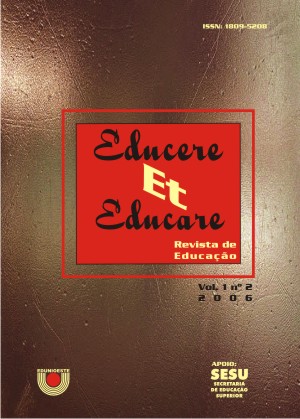TENSÃO ESTÉTICA: DISSONÂNCIA ENTRE ELEMENTOS DA TRAGÉDIA E O CONTEÚDO ÉPICO NA OBRA "O PUNHO"
DOI:
https://doi.org/10.17648/educare.v1i2.263Palavras-chave:
Forma, conteúdo, teatro épico e trágico, questão agráriaResumo
Neste artigo, parte-se da premissa de que, em uma obra literária, os aspectos ideológicos encontram-se presentes não só nos fatores sócio-culturais abordados pelo autor, mas também na forma estética dada à obra. Isso porque caracteres ideológicos fundem-se indissoluvelmente à realidade material do signo, que, por sua vez, não pode ser separado da forma que adquire o todo do enunciado. Desse modo, o procedimento analítico aqui adotado volta-se para o conteúdo temático, o estilo verbal e a construção composicional como componentes indissociáveis entre si, buscando na construção estética da obra O Punho (1980) de Bernardo Santareno os elementos que deixam transparecer a discordância entre o conteúdo de caráter épico, que fundamenta a temática da obra, e o desvio que ocorre, em vários momentos ao longo da fábula, para o conflito de ordem individual da personagem protagonista.Downloads
Publicado
07-12-2007
Como Citar
BONIATTI, E.; BRENNEISEN, E. TENSÃO ESTÉTICA: DISSONÂNCIA ENTRE ELEMENTOS DA TRAGÉDIA E O CONTEÚDO ÉPICO NA OBRA "O PUNHO". Educere et Educare, [S. l.], v. 1, n. 2, p. p. 179–195, 2007. DOI: 10.17648/educare.v1i2.263. Disponível em: https://saber.unioeste.br/index.php/educereeteducare/article/view/263. Acesso em: 19 dez. 2025.
Edição
Seção
Artigos e Ensaios
Licença
Aviso de Direito Autoral Creative Commons
Política para Periódicos de Acesso Livre
Autores que publicam nesta revista concordam com os seguintes termos:
1. Autores mantém os direitos autorais e concedem à revista o direito de primeira publicação, com o trabalho simultaneamente licenciado sob a Licença Creative Commons Attribution que permite o compartilhamento do trabalho com reconhecimento da autoria e publicação inicial nesta revista.2. Autores têm autorização para assumir contratos adicionais separadamente, para distribuição não-exclusiva da versão do trabalho publicada nesta revista (ex.: publicar em repositório institucional ou como capítulo de livro), com reconhecimento de autoria e publicação inicial nesta revista.
3. Autores têm permissão e são estimulados a publicar e distribuir seu trabalho online (ex.: em repositórios institucionais ou na sua página pessoal) a qualquer ponto antes ou durante o processo editorial, já que isso pode gerar alterações produtivas, bem como aumentar o impacto e a citação do trabalho publicado (Veja O Efeito do Acesso Livre).
Licença Creative Commons
Esta obra está licenciada com uma Licença Creative Commons Atribuição-NãoComercial-CompartilhaIgual 4.0 Internacional, o que permite compartilhar, copiar, distribuir, exibir, reproduzir, a totalidade ou partes desde que não tenha objetivo comercial e sejam citados os autores e a fonte.


